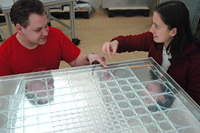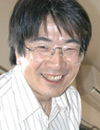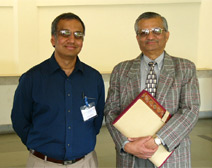 |
|
|
 |
Ten Thousand Eyes On New Physics

Erika Garutti and a technician, Oleg Chernyshov, checking the "eyes" of the seventh layer for the prototype of the hadron calorimeter, an essential part of future ILC detectors. |
In a tent in a test hall at DESY in Hamburg, Germany, the hadron calorimeter is learning how to see. This calorimeter - an essential part in all proposed detector designs for the ILC - measures the energy of all those particles that make it through the dense electromagnetic calorimeter. It does this with the help of scintillators, small plastic plates where incoming particles interact, leaving information of their energies, a fibre that changes the photons' wavelengths from ultraviolet to green, and tiny photodetectors that convert the light into an electronic signal. Hadrons interact with layers of dense metal, producing the charged particles whose signal is measured and conclusions can be drawn on the energy and nature of the hadron that swooshed past.
So far nothing new, hadron calorimeters have been used in particle detectors for a long time. This one, however, is special. "At the ILC, we want to be able to reconstruct every single particle that is created in the collision of the electron-positron beams," explains Erika Garutti, an Italian physicist working on the detector part's prototype at DESY. "To be able to see possible new physics we need extremely good eyes. We also need very small eyes to distinguish all the details. This system will be unprecedented in its granularity and precision," says Erika.
This hadron calorimeter prototype is part of the CALICE project ("CAlorimeter for the LInear Collider Experiment"). About 200 physicists from 32 institutes in nine countries are working on it. Soon they will be able to do so without leaving their desks: Their project is the first to try out an e-log system developed by the TESLA Technology collaboration that will allow remote access from all over the world to check the status and change the controls of the system. The control room of the future?
Read more...
-- Barbara Warmbein
|
 |
|
|
 |
|
Upcoming meetings, conferences, workshops
International Symposium on Detector Development in Particle and Astroparticle Physics and Synchrotron Radiation
SLAC
3-6 April 2006
ILC Americas Regional Team Review
ILC - Americas
FNAL
4-6 April 2006
ILC Software and Physics Meeting
Cambridge
4-6 April 2006
MAC Review
Fermilab
6-7 April 2006
International Accelerator School for Linear Colliders
Sokendai, Graduate School for Advanced Studies
Hayama, Japan
19-27 May 2006
InterAction Meeting on ILC
KEK
29-30 May 2006
ILC Communicators Meeting
KEK
31 May 2006
ILC VTX Workshop at Ringberg
Ringberg Castle, Lake Tegernsee, Germany
28-31 May 2006
CALOR 2006
12th International Conference on Calorimetry in High Energy Physics
Chicago, USA
5-9 June 2006
Vancouver Linear Collider Workshop
Vancouver, Canada
19-23 July 2006
ILC GDE Meeting
Vancouver, Canada
19-23 July 2006
Single Crystal Niobium Technology Workshop (pdf)
Araxá mine in Brazil
30 October-1 November 2006
Request Information (email)
ILC GDE Meeting
Valencia, Spain
6-10 November 2006
|
|
 |
 |
|
|
 |
Costing Guidelines for the Reference Design Report Available Online
While figuring out how to smash electrons and positrons at an energy level of 500 GeV in a tunnel that is approximately 25 kilometers long could be considered a minor challenge, one of the largest hurdles for the International Linear Collider is developing accurate costing estimates. While at first estimating the cost of something might not sound that hard (some of us do it almost every day for groceries, house supplies, and of course shoes), there are a number of factors that will make costing an extremely complicated process for a global project like the ILC.
Because costing is done differently in each region of the world, the Global Design Effort must develop a solid procedure for producing accurate estimates – something that is crucial for the success of the project. The GDE has been working diligently on researching costing methodologies that can yield "international" or "value" costs. These value costs must be reliably converted for different countries where such things as labor costs, risk assessment and engineering expenses are treated in different ways. As a result of six months of researching international costing and following the meeting in Bangalore, the Design and Cost Board drafted a set of Costing Guidelines for the Reference Design Report. The two-page document provides some preliminary guidelines. "We hope that this will be a useful start for producing estimates," said Peter Garbincius, Chair of the Design and Cost Board. "There will be more details to come, and we welcome your feedback."
The Costing Guidelines are available online (pdf).
-- Elizabeth Clements
|
 |
|
|
 |
Caring for Asian Accelerators

Shin-ichi Kurokawa |
Shin-ichi Kurokawa works actively as Chair of the International Linear Collider Steering Committee (ILCSC), which together with ICFA has created and is overseeing activities of the Global Design Effort. But he also has another face: For more than ten years now, he has been building a closer relationship between accelerators within Asia. His concern is not only for the electron machines but also for proton machines, synchrotron radiation facilities, and eventually, neutron scattering facilities in Asian countries.
Read more...
-- Youhei Morita
|
 |
|
|
 |
From XFEL
21 March 2006
The First Measuring Period at DESY’s New Free-Electron Laser VUV-FEL Successfully Concluded: Confirmation of Future Possibilities of Scientific Application
The first measuring period for external users at the new X-ray radiation source VUV-FEL at DESY in Hamburg has been successfully concluded. Since its official startup in August 2005, a total of 14 research teams from ten countries have carried out first experiments using the facility’s intense laser beam. "Both the external researchers and the DESY team gained most valuable experience with the new machine," DESY research director Professor Jochen Schneider comments.
Read more...
From SciDAC Review
March 2006
Designing accelerators: PRECISION PROBES for scientific discovery
"...The International Linear Collider project is intended to explore energy regions previously inaccessible to controlled experiments. Some 12 countries and about 20 group leaders are teaming together to understand the compelling questions that still elude answers - from the structure of the universe and space-time to the nature of dark matter, dark energy and extra dimensions. The US high-energy physics community is involved closely in this effort as is the AST project."
Read more...
From Fermilab Today
24 March 2006
A Peek Behind the Scenes: In the Lab's Clean Rooms
"...Soon, however, the SiDet Center will lose its claim as the cleanest rooms at the lab to an ILC cavity string assembly clean room being constructed at building MP9 as a part of the Cryomodule Assembly Facility (CAF). This series of clean rooms will include a class 1,000 "ante clean room," class 100 "clean storage area" and class 10 "assembly area.""
Read more... |
|
 |
 |
|
|
 |
Thanks, Fumi... Welcome, Mitsuaki

Professor Mitsuaki Nozaki |
It is my great pleasure to announce the appointment of Professor Mitsuaki Nozaki of Kobe University of Japan as the new GDE Asian Regional Director, succeeding Professor Fumihiko Takasaki.
Following my appointment as GDE director one year ago, the first key appointments I made were the three regional directors: Brian Foster for Europe, Gerry Dugan for the Americas and Fumihiko Takasaki for Asia. Our three regional directors were given the charge of coordinating the programs within the GDE for Europe, Asia and the Americas and helping implement the projects and priorities within those regions. We have been very fortunate to have three outstanding regional directors.
As we developed a globally conceived "baseline configuration" last year, the regional directors played a critical role in insuring that our processes were truly global, regional interests were understood, and we balanced the global needs and priorities against regional interests. Balancing these interests is a crucial element in developing a truly global design, a global R&D program and international management for the International Linear Collider.
As regional coordinator for Asia, Fumihiko Takasaki played a crucial role in developing the Asian GDE effort over the past year. The Asian ILC and GDE efforts include an ambitious and growing R&D program at KEK, strong participation in the GDE Baseline and RDR efforts, and a broadening participation in the GDE and ILC. Fumi has been energetic and instrumental both in developing the Asian regional program, and in serving as a member of the GDE Executive Committee, where our top level global policy decisions are made.
I have very much valued Fumi's role on the GDE Executive Committee and we have relied on his advice. Unfortunately for us, Fumi's great talents are also well recognized at home, and he has been appointed as the directorship of Institute of Particle and Nuclear Studies (IPNS) at KEK as of 1 April 2006. In this new position, he will no longer be able to serve as the Asian Regional GDE Director. I wish him well in his new position, and am confident he will do an outstanding job.
Our new Asian Regional Coordinator, Mitsuaki Nozaki, is the chair of the Japanese High Energy Physics Committee (JHEPC). Mitsuaki will be moving from Kobe to KEK, where he will become a Professor and the Deputy Director of Institute of Particle and Nuclear Studies (IPNS), as well as serving in his new role in the GDE...
Read more...
--Barry Barish
Director's Corner Archive
|
 |
|
|
 |
SLAC Hosts International Detector Symposium
The International Symposium on the Development of Detectors for Particle, Astroparticle and Synchrotron Radiation Experiments will take place next week at SLAC on 3-6 April. The goal of this symposium is to bring together experts from different communities to exchange information and stimulate interdisciplinary developments.
Conference website
MAC Review at Fermilab Next Week
The Machine Advisory Committee will hold a review at Fermilab on 6-7 April. An agenda is available online.
ILC Related Preprints
hep-ph/0603197
23 Mar 2006
Mixed Higgsino Dark Matter from a Reduced SU(3) Gaugino Mass:
Consequences for Dark Matter and Collider Searches
|
 |
|
|
 |
|

Fermilab's Shekhar Mishra (left) stands with Anil Kakodkar, Chairman of the Atomic Energy Commission and Secretary of the Department of Atomic Energy in India at the recent Linear Collider Workshop. Kakodkar inaugurated the workshop, located in Bangalore, and expressed his enthusiasm for India hosting this international meeting. In an interview, he explained the benefit of participating in an international scientific community, such as the ILC, on the whole society -- from young students to industry.
|
|

